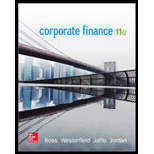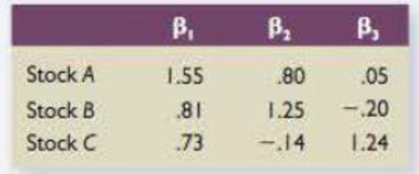
Corporate Finance (The Mcgraw-hill/Irwin Series in Finance, Insurance, and Real Estate)
11th Edition
ISBN: 9780077861759
Author: Stephen A. Ross Franco Modigliani Professor of Financial Economics Professor, Randolph W Westerfield Robert R. Dockson Deans Chair in Bus. Admin., Jeffrey Jaffe, Bradford D Jordan Professor
Publisher: McGraw-Hill Education
expand_more
expand_more
format_list_bulleted
Concept explainers
Textbook Question
Chapter 12, Problem 4QP
Multifactor Models Suppose stock returns can be explained by the following three-factor model:
Ri = RF + β1F1 + β2F2 – β3F3
Assume there is no firm-specific risk. The information for each stock is presented here:

The risk premiums for the factors are 4.9 percent 3.8 percent and 5.3 percent, respectively. If you create a portfolio with 20 percent invested in Stock A, 20 percent invested in Stock 8, and the remainder in Stock C, what is the expression for the return on your portfolio? If the risk-free rate is 3.2 percent, what is the expected return on your portfolio?
Expert Solution & Answer
Want to see the full answer?
Check out a sample textbook solution
Students have asked these similar questions
Question:
Assume that using the Security Market Line (SML) the required rate of return (RA) on stock A is found to be half of the required return (RB) on stock B. The risk-free rate (Rf) is one-fourth of the required return on A. Return on market portfolio is denoted by RM. Find the ratio of beta of A to beta of B.
Suppose that the market can be described by the following three sources of systematic risk with associated risk premiums.
Risk Premium
Factor
Industrial production (I)
Interest rates (R)
Consumer confidence (C)
Required:
8%
4
7
The return on a particular stock is generated according to the following equation:
r = 17% +0.9/+0.5R+0.70 C+ e
a-1. Find the equilibrium rate of return on this stock using the APT. The T-bill rate is 3%.
Note: Do not round intermediate calculations. Round your answer to 1 decimal place.
a-2. Is the stock over- or underpriced?
a-1. Equilibrium rate of return
a-2 Is the stock over- or underpriced?
%
Suppose we have the following information:
Securit Amount Invested Expected Return Beta Stock
A RM1 ,OOO 8% 0.80
Stock B RM2,OOO 12% 0.95
Stock C RM3,OOO 15% 1.10
Stock D RM4,OOO 18%
a) Compute the expected return on this portfolio.
b) Calculate the beta of the portfolio.
c) Does this portfolio have more or less systematic risk than an average asset? Explain.
Chapter 12 Solutions
Corporate Finance (The Mcgraw-hill/Irwin Series in Finance, Insurance, and Real Estate)
Ch. 12 - Prob. 1CQCh. 12 - Prob. 2CQCh. 12 - Prob. 3CQCh. 12 - Prob. 4CQCh. 12 - Market Model versus APT What are the differences...Ch. 12 - APT In contrast to the CAPM, the APT does not...Ch. 12 - CAPM versus APT What is the relationship between...Ch. 12 - Prob. 8CQCh. 12 - Data Mining What is data mining? Why might it...Ch. 12 - Prob. 10CQ
Ch. 12 - Prob. 1QPCh. 12 - Factor Models Suppose a three-factor model is...Ch. 12 - Prob. 3QPCh. 12 - Multifactor Models Suppose stock returns can be...Ch. 12 - Prob. 5QPCh. 12 - Market Model The following three stocks are...Ch. 12 - Prob. 7QPCh. 12 - Prob. 8QPCh. 12 - APT Assume that the following market model...Ch. 12 - Prob. 10QP
Knowledge Booster
Learn more about
Need a deep-dive on the concept behind this application? Look no further. Learn more about this topic, finance and related others by exploring similar questions and additional content below.Similar questions
- Assume that using the Security Market Line(SML) the required rate of return(RA)on stock A is found to be halfof the required return (RB) on stock B. The risk-free rate (Rf) is one-fourthof the required return on A. Return on market portfolio is denoted by RM. Find the ratioof betaof A(A) tobeta of B(B). Thank you for your help.arrow_forwardYou are given the following information concerning three portfolios, the market portfolio, and the risk-free asset: Portfolio X Y Z Market Risk-free Rp 14.0% 13.0 .8.5 12.0 7.2 Ор 39.00% 34.00 24.00 29.00 0 Bp 1.50 1.15 0.90 1.00 0 Assume that the correlation of returns on Portfolio Y to returns on the market is 0.90. What percentage of Portfolio Y's return is driven by the market? Note: Enter your answer as a decimal not a percentage. Round your answer to 4 decimal places. R-squaredarrow_forwardSuppose that the market can be described by the following three sources of systematic risk with associated risk premiums. Factor Risk Premium Industrial production (I) 8 % Interest rates (R) 4 % Consumer confidence (C) 6 % The return on a particular stock is generated according to the following equation: r = 16% + 1.6I + 0.8R + 1.30C + e a-1. Find the equilibrium rate of return on this stock using the APT. The T-bill rate is 4%. (Do not round intermediate calculations. Round your answer to 1 decimal place.) a-2. Is the stock over- or underpriced?arrow_forward
- Assume an economy in which there are three securities: Stock A with rA = 10% and σA = 10%; Stock B with rB = 15% and σB = 20%; and a riskless asset with rRF = 7%. Stocks A and B are uncorrelated (rAB = 0). Which of the following statements is most CORRECT? 1. b. The expected return on the investor’s portfolio will probably have an expected return that is somewhat below 10% and a standard deviation (SD) of approximately 10%. 2. d. The investor’s risk/return indifference curve will be tangent to the CML at a point where the expected return is in the range of 7% to 10%. 3. e. Since the two stocks have a zero correlation coefficient, the investor can form a riskless portfolio whose expected return is in the range of 10% to 15%. 4. a. The expected return on the investor’s portfolio will probably have an expected return that is somewhat above 15% and a standard deviation (SD) of approximately 20%. 5.…arrow_forwardSuppose that the market can be described by the following three sources of systematic risk with associated risk premiums. Factor Risk Premium Industrial production (I) 6 % Interest rates (R) 2 Consumer confidence (C) 4 The return on a particular stock is generated according to the following equation: r = 15% + 1.0I + 0.5R + 0.75C + ea-1. Find the equilibrium rate of return on this stock using the APT. The T-bill rate is 6%. (Do not round intermediate calculations. Round your answer to 1 decimal place.)arrow_forwardAssume that using the Security Market Line (SML) the required rate of return (RA) on stock A is foundto be half of the required return (RB) on stock B. The risk-free rate (Rf) is one-fourth of the requiredreturn on A. Return on market portfolio is denoted by RM. Find the ratio of beta of A (A) to beta of B(B). d) Assume that the short-term risk-free rate is 3%, the market index S&P500 is expected to payreturns of 15% with the standard deviation equal to 20%. Asset A pays on average 5%, has standarddeviation equal to 20% and is NOT correlated with the S&P500. Asset B pays on average 8%, also hasstandard deviation equal to 20% and has correlation of 0.5 with the S&P500. Determine whetherasset A and B are overvalued or undervalued, and explain why. (Hint: Beta of asset i (??) = ???????, where ??,?? are standard deviations of asset i and marketportfolio, ??? is the correlation between asset i and the market portfolio)arrow_forward
- Assume that using the Security Market Line (SML) the required rate of return (RA) on stock A is foundto be half of the required return (RB) on stock B. The risk-free rate (Rf) is one-fourth of the requiredreturn on A. Return on market portfolio is denoted by RM. Find the ratio of beta of A (A) to beta of B(B). d) Assume that the short-term risk-free rate is 3%, the market index S&P500 is expected to payreturns of 15% with the standard deviation equal to 20%. Asset A pays on average 5%, has standarddeviation equal to 20% and is NOT correlated with the S&P500. Asset B pays on average 8%, also hasstandard deviation equal to 20% and has correlation of 0.5 with the S&P500. Determine whetherasset A and B are overvalued or undervalued, and explain why. (Hint: Beta of asset i (??) =???????, where ??,?? are standard deviations of asset i and marketportfolio, ??? is the correlation between asset i and the market portfolio)Question 2. Foreign exchange marketsStatoil, the national…arrow_forwardQuestions C and D is required. c) Assume that using the Security Market Line (SML) the required rate of return (RA) on stock A is found to be half of the required return (RB) on stock B. The risk-free rate (Rf) is one-fourth of the required return on A. Return on market portfolio is denoted by RM. Find the ratio of beta of A (A) to beta of B (B). d) Assume that the short-term risk-free rate is 3%, the market index S&P500 is expected to pay returns of 15% with the standard deviation equal to 20%. Asset A pays on average 5%, has standard deviation equal to 20% and is NOT correlated with the S&P500. Asset B pays on average 8%, also has standard deviation equal to 20% and has correlation of 0.5 with the S&P500. Determine whether asset A and B are overvalued or undervalued, and explain why. (Hint: Beta of asset i ( , where are standard deviations of asset i and market portfolio, is the correlation between asset i and the market portfolio)arrow_forward3. The following information is given with respect to stock A: Scenario Probability Market return 1 0.1 -0.18 2 0.3 0.07 3 0.4 0.16 4 0.2 0.21 Knowing that the Rfis 0.07 compute alpha and the information ratio. Portfolio P return -0.32 0.00 0.22 0.40arrow_forward
- You are given the following information concerning three portfolios, the market portfolio, and the risk-free asset: Portfolio Y Z Market Risk-free Rp 13.5% бр 35.00% 12.5 30.00 7.1 20.00 10.6 4.4 25.00 0 Вр 1.55 1.20 0.80 1.00 0 Assume that the correlation of returns on Portfolio Y to returns on the market is 0.70. What percentage of Portfolio Y's return is driven by the market? Note: Enter your answer as a decimal not a percentage. Round your answer to 4 decimal places. × Answer is complete but not entirely correct. R-squared 0.9785arrow_forwardConsider the following simplified APT model: Factor Expected Risk Premium Market 6.4% Interest Rate -0.6% Yield Spread 5.1% Factor Risk Exposures Market Interest Rate Yield Spread Stock Stock(b1) (b2) (b3) P 1.0 -2.0 -0.2 P2 1.2 0 0.3 P3 0.3 0.5 1.0 Required: 1. Calculate the expected return for the above stocks. Assume risk free rate is 5%. Consider a portfolio with equal investments in stocks P, P2 and P3 2.What are the factor risk exposures for the portfolio? 3.What is the portfolio’s expected return?arrow_forwardAssume that using the Security Market Line (SML) the required rate of return (RA) on stock A is found to be half of the required return (RB) on stock B. The risk-free rate (Rf) is one-fourth of the required return on A. Return on market portfolio is denoted by RM. Find the ratio of beta of A (bA) to beta of B (bB). please show all workings and not merely : Ra = 1/2 rbRf = 1/4 Raarrow_forward
arrow_back_ios
arrow_forward_ios
Recommended textbooks for you
 EBK CONTEMPORARY FINANCIAL MANAGEMENTFinanceISBN:9781337514835Author:MOYERPublisher:CENGAGE LEARNING - CONSIGNMENT
EBK CONTEMPORARY FINANCIAL MANAGEMENTFinanceISBN:9781337514835Author:MOYERPublisher:CENGAGE LEARNING - CONSIGNMENT

EBK CONTEMPORARY FINANCIAL MANAGEMENT
Finance
ISBN:9781337514835
Author:MOYER
Publisher:CENGAGE LEARNING - CONSIGNMENT
Portfolio return, variance, standard deviation; Author: MyFinanceTeacher;https://www.youtube.com/watch?v=RWT0kx36vZE;License: Standard YouTube License, CC-BY